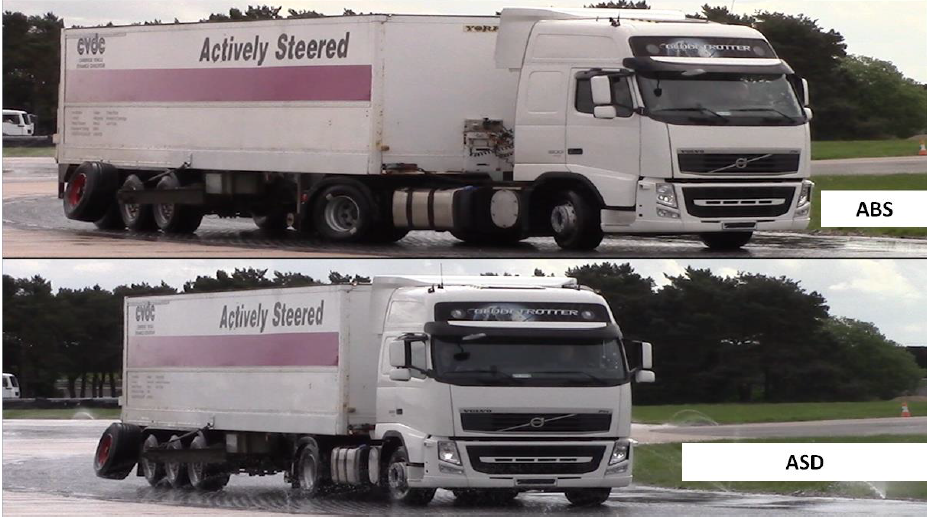
Submitted by Prof. D. Cebon on Sat, 12/03/2016 - 12:07
Graeme Morrison's PhD dissertation 'Combined Emergency Braking and Cornering of Articulated Heavy Vehicles' has been approved by the university.
The research project investigated the behaviour of heavy goods vehicles with slip-controlled braking systems under combined emergency braking and steering manoeuvres. An 'Attenuated Slip Demand' control strategy was developed to ensure that the vehicles maintain directional control while also gaining the substantial stopping performance improvements available from wheel slip control over conventional EBS . The work was performed in collaboration with members of the Cambridge Vehicle Dynamics Consortium www.cvdc.org.
Summary
Emergency stopping distances of heavy goods vehicles (HGVs) are typically much longer than those of passenger cars, due to the inefficiency of their pneumatic anti-lock braking systems (ABS). This has motivated research to develop “slip control” braking for HGVs. Up to 19% stopping distance reductions have been demonstrated, but little consideration has been given to the effect on the primary ABS function: provision of directional stability and controllability. This thesis investigates the combined emergency braking and cornering performance of HGVs equipped with slip control. An improved vehicle control strategy is demonstrated, which outperforms conventional ABS with respect to both stopping distances and directional dynamics.
Relevant literature is reviewed in Chapter 1 and the research objectives are established. Nonlinear simulations of a tractor-semitrailer are developed and experimentally validated in Chapter 2, primarily for use in the design and tuning of controllers.
Chapter 3 uses the simulations to demonstrate that while slip control can greatly reduce stopping distances, this may come at the expense of directional performance. An “attenuated slip demand” (ASD) controller is designed to overcome this. The controller compares vehicle states to a linear reference model, then attenuates slip on individual axles to restore lateral tyre forces as necessary.
In Chapter 4 the controller is implemented on an articulated test vehicle, equipped with both a slip control braking system and conventional ABS. Back-to-back tests of conventional ABS and slip control with and without ASD are conducted on low friction surfaces. With ASD a substantial directional performance improvement is demonstrated relative to conventional ABS, while still maintaining 3-7% shorter stopping distances during cornering. In straight-line braking, the full 19% stopping distance reduction of slip control can still be achieved.
Chapter 5 considers estimation of sideslip angle when near the limits of adhesion. This would be necessary for commercialisation of ASD. State-of-the-art estimators for HGVs are shown to be insufficient and three new nonlinear estimators are designed. Simulations and post-processing of experimental data demonstrate that an unscented Kalman filter, using a yaw-roll vehicle model with linear adaptive tyres, should be sufficiently accurate for ASD to function.
Chapter 6 investigates extremum seeking algorithms to generate the slip control reference, as an alternative to computationally expensive tyre model fitting. Computer and hardware-in-the-loop simulations suggest that this is feasible and could be integrated with an ASD-style controller.
Finally, conclusions are drawn in Chapter 7 and recommendations are made for future work.

